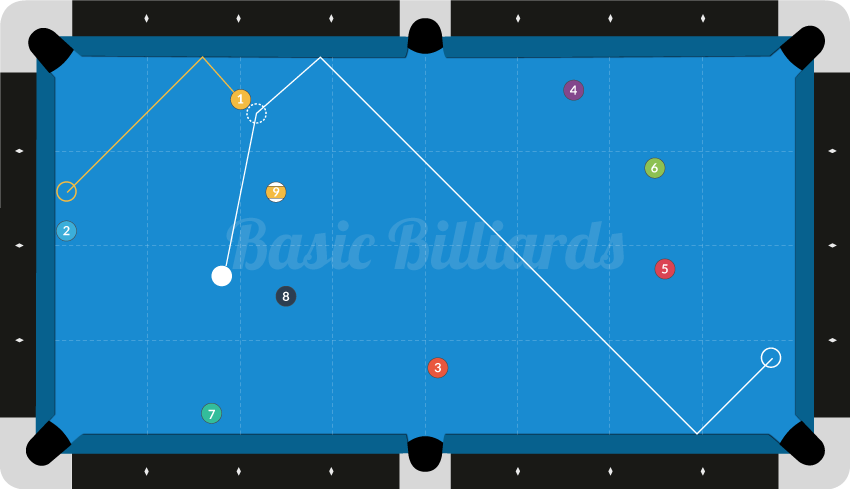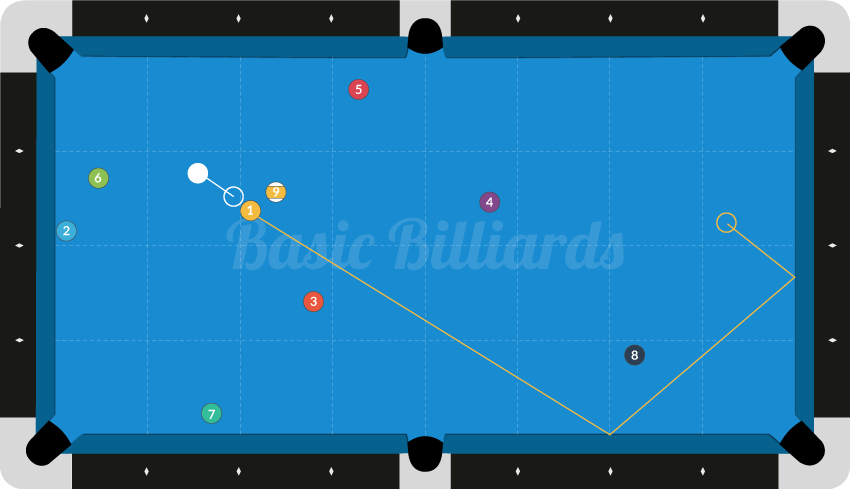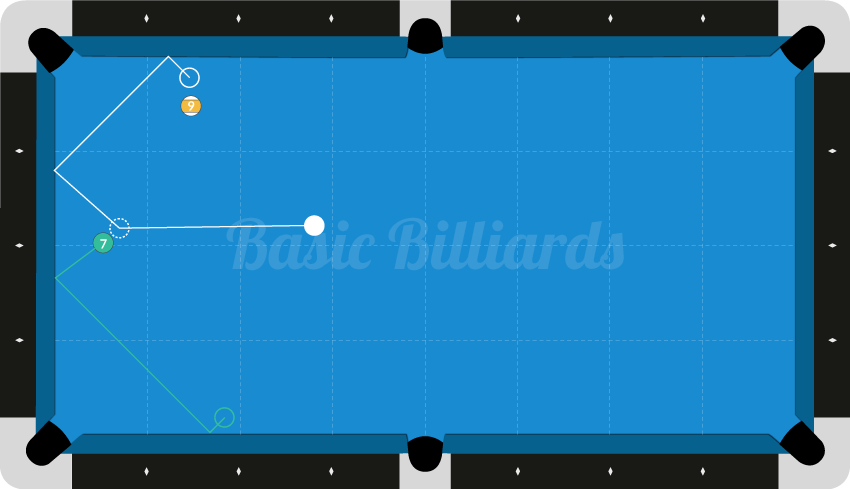Most of the lessons on this site are high level principles can be used in any game to get an advantage over an opponent. However, 9 ball and 10 ball are both hugely popular rotation games where a solid defense is as valuable as a good offense. There are several safeties that come up every match so you should know and practice them. Well executed safeties are clinical when you succeed in pulling them off and its something advanced players are skilled at performing on a regular basis. Before getting into common safeties makes sure that you’re familiar with the elements to a good safety. so you understand the principles for completing these safeties.
Containing Safety on the Short Rail
A good containing safety is when you don’t leave an open shot for your opponent. A common and effective containing safety is to the object ball on the middle of the bottom rail and the cue ball is directly across the table making it impossible to cut the ball into a pocket only leaving a bank. In some cases the bank could be a good shot. It depends on the possible outcome and your confidence in your banking skills. Most of the time though a safety is the better option.
In this position you could play a bank shot, but why take the risk? If you miss you’ll probably sell out, and if you make the 1 ball the cue ball is going away from the 2 so there’s no reward for making the bank. To put the odds of winning the match back in your favor, play a safety instead.

With high right English you can send the cue ball to the short rail on the other end of the table while at the same time banking the 1 ball to the middle of the short rail. With all the balls on the table you have a good chance of hiding behind at least one of them and not leaving a clear shot at the one. This would mean you have a very good chance of getting a makeable shot during your next turn at the table and possibly even ball in hand. If you don’t hide behind another ball then you’ve still left distance and no makeable shot which is still a good outcome for you.
Keep in mind:
You need to make sure that the one ball doesn’t end up in front of the corner pocket leaving an easy shot for your opponent. An easy mistake to make is to focus too much on cue ball position on this shot and forget about where you need to leave the 1 ball. The most important part of this shot is leaving the 1 ball on the middle of the short rail. This shot is worth practicing for 5 minutes during your practice sessions since it comes up so often and is easy to execute.
Stop Shot Safety
One of the most powerful shots in pool is the stop shot. The reason it’s so great is because it allows you to precisely predict exactly where the cue ball will end up. Most novices can figure out how to perform a stop shot consistently so even they can use this shot to their advantage.
Instead of taking risky shots, a stop shot is a great tool to use to hide the cue ball behind blockers close by. In the example below, you can perform a stop shot to hide behind the 9 ball. This shot is fantastic because it leaves the cue ball close to the 9 cutting away a multitude of kicking options. The closer you get to a blocker the better. Proximity takes away jumping options as well as kicks which increase your chances of a shot back at the table. The other reason this is a good safety is because if you leave the object ball a little off the short rail like in the diagram it’s a much smaller ball to hit.

Keep in mind:
A pitfall that you can fall into with this safety is lack of attention to the path of the 1 ball. Without the proper care the 1 ball could end up hitting the 8 ball and instead of ending up safe it could lay in front of the corner pocket or you might even make it which would result in a more difficult safety to play on the 2 ball. It important to visualize the path you want the 1 ball to take before you shoot the shot so it stays out of trouble and gives you the result you want.
Middle of Short Rail
At the end of the game you might mess up position or your opponent could play a safety that leaves the object ball in the middle of the short rail and the cue ball right across from it. We already know we don’t need to panic since there’s probably a solid safety solution we can play to help get out of this jam.

If you play a half ball hit on the 7 ball you can leave it on the side rail and leaving your opponent without a shot. At the same time this should leave the cue ball on the other side rail. With the right speed you can even hide behind the 9 ball in this situation. However, the focus should be to leave the 7 in an unmakeable position and the cue ball on the rail to leave difficult cueing for the other player.
These are only 3 common safeties that come up during 9 ball games and are by no means an exhaustive list. However, by simply knowing these shots you give yourself a much better chance of winning many more matches than you otherwise would have. To learn other safeties, you need to play players that are better than you and observe the way they play, you can watch professional players online, or look at other resources on safeties to improve.
